Related Research Articles

Milton Berle was an American actor and comedian. His career as an entertainer spanned over eight decades, first in silent films and on stage as a child actor, then in radio, movies and television. As the host of NBC's Texaco Star Theatre (1948–1953), he was the first major American television star and was known to millions of viewers as "Uncle Miltie" and "Mr. Television" during the first Golden Age of Television. He was honored with two stars on the Hollywood Walk of Fame for his work in both radio and TV.
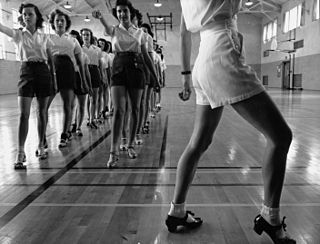
Tap dance is a form of dance that uses the sounds of tap shoes striking the floor as a form of percussion; it is often accompanied by music. Tap dancing can also be a cappella, with no musical accompaniment; the sound of the taps is its own music.
An Aerial is a dance move in Lindy Hop or Boogie Woogie where one's feet leave the floor. As opposed to a lift, aerial is a step where a partner needs to be thrown into the air and then landed in time with the music. Each aerial consists of a preparation ('prep'), jump or trick itself and the landing.

Aerobics is a form of physical exercise that combines rhythmic aerobic exercise with stretching and strength training routines with the goal of improving all elements of fitness. It is usually performed to music and may be practiced in a group setting led by an instructor. With the goal of preventing illness and promoting physical fitness, practitioners perform various routines. Formal aerobics classes are divided into different levels of intensity and complexity and will have five components: warm-up, cardiovascular conditioning, muscular strength and conditioning, cool-down and stretching and flexibility. Aerobics classes may allow participants to select their level of participation according to their fitness level. Many gyms offer different types of aerobic classes. Each class is designed for a certain level of experience and taught by a certified instructor with a specialty area related to their particular class.
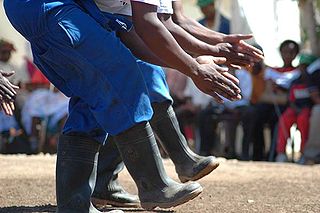
The gumboot dance is a South African dance that is performed by dancers wearing wellington boots. In South Africa these are more commonly called gumboots.

Bill Robinson, nicknamed Bojangles, was an American tap dancer, actor, and singer, the best known and the most highly paid Black entertainer in the United States during the first half of the 20th century. His long career mirrored changes in American entertainment tastes and technology. His career began in the age of minstrel shows and moved to vaudeville, Broadway theatre, the recording industry, Hollywood films, radio, and television.
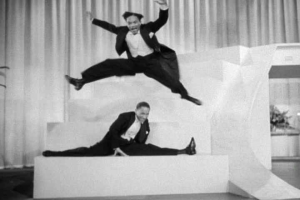
The Nicholas Brothers were an entertainment act composed of brothers, Fayard (1914–2006) and Harold (1921–2000), who excelled in a variety of dance techniques, primarily between the 1930s and 1950s. Best known for their unique interpretation of a highly acrobatic technique known as "flash dancing", they were also considered by many to be the greatest tap dancers of their day, if not all time. Their virtuoso performance in the musical number "Jumpin' Jive" featured in the 1943 movie Stormy Weather has been praised as one of the greatest dance routines ever captured on film.
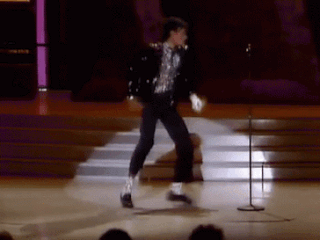
The moonwalk, or backslide, is a popping dance move in which the performer glides backwards but their body actions suggest forward motion. It became popular around the world when Michael Jackson performed the move during the performance of "Billie Jean" on Motown 25: Yesterday, Today, Forever, which was broadcast in 1983. He included the moonwalk in tours and live performances. Jackson has been credited as renaming the "backslide" to the moonwalk and it became his signature move.
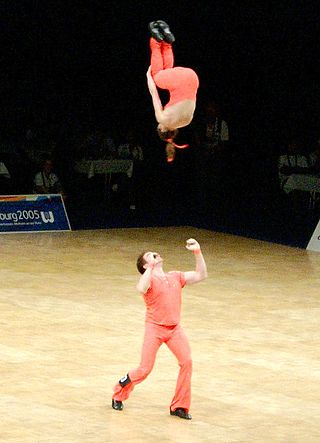
Acrobatic rock and roll is a fast, athletic, physically demanding form of partner dance that originated from Lindy Hop but has evolved to a choreographed sport, often done in formal competition. It is danced by both couples and groups, either all-female or four to eight couples together.

The Major Bowes Amateur Hour was an American radio talent show broadcast in the 1930s and 1940s, created and hosted by Edward Bowes (1874–1946). Selected performers from the program participated in touring vaudeville performances, under the "Major Bowes" name. The program later transitioned to television under host Ted Mack.

The Show of Shows is a 1929 American pre-Code musical revue film directed by John G. Adolfi and distributed by Warner Bros. The all-talking Vitaphone production cost almost $800,000 and was shot almost entirely in Technicolor.
Henry LeTang was an American theatre, film, and television choreographer and a dance instructor.
Maceo Anderson was an American dancer.

Acro dance is a style of dance that combines classical dance technique with acrobatic elements. It is defined by its athletic character, its unique choreography, which blends dance and acrobatics, and its use of acrobatics in a dance context. It is a popular dance style in amateur competitive dance as well as in professional dance theater and in contemporary circus productions such as those by Cirque du Soleil. This is in contrast to acrobatic, artistic and rhythmic gymnastics, which are sports that employ dance elements in a gymnastics context under the auspices of a governing gymnastics organization and subject to a Code of Points. Acro dance is known by various other names including acrobatic dance and gymnastic dance, though it is most commonly referred to simply as acro by dancers and dance professionals.
Ernest "Brownie" Brown was an African American tap dancer and last surviving member of the Original Copasetics. He was the dance partner of Charles "Cookie" Cook, with whom he performed from the days of vaudeville into the 1960s, and of Reginald McLaughlin, also known as "Reggio the Hoofer," from 1996 until Brown's death in 2009.
The Flo-Bert Award honors "outstanding figures in the field of tap dance".
Spelbound are a gymnastic troupe from the United Kingdom who rose to fame in 2010, winning the fourth series of Britain's Got Talent. The prize was £100,000 and the opportunity to appear at the 2010 Royal Variety Performance. They also performed in the Britain's Got Talent Live tour. They have since performed at numerous venues and have been featured in advertisements.

The Strictly is a signature dance routine from the BBC show Strictly Come Dancing, which launched in the 13th series of the popular entertainment show. The dance was devised by Strictly Come Dancing's Director of Choreography, Jason Gilkison and draws inspiration from some of the show's most iconic moves, as well as celebrating some of the show's stars.
Tip, Tap, and Toe were a seminal African-American tap-dance comedy act that began in the late 1920s and appeared in several motion pictures in the 1930s and '40s. Its original members were Sammy Green, Teddy Frazier, and Raymond Winfield. At times it included Freddie James and Prince Spencer, also a member of The Four Step Brothers. They worked for Eddie Cantor at Palace Theatre in New York and performed on their own at the Paramount Theatre, and were in George White's Scandals of 1936 and the Cotton Club Review. African-Americans were not allowed to star in major motion pictures in the 1930s and '40s, but specialty acts, such as Tip, Tap, and Toe, were permitted, and the group appeared in at least five major Hollywood films during that time.

Miller Brothers and Lois, a renowned tap dance class act team, comprising Danny Miller, George Miller and Lois Bright, was a peak of platform dancing with the tall and graceful Lois said to distinguish the trio. The group performed the majority of their act on platforms of various heights, with the initial platform spelling out M-I-L-L-E-R. They performed over-the-tops, barrel turns and wings on six-foot-high pedestals. They toured theatres coast to coast with Jimmy Lunceford and his Orchestra, Cab Calloway and his Orchestra, and the Count Basie Band.
References
- 1 2 Dunning, Jennifer (July 14, 2001). "Maceo Anderson, 90, Tap Dancer, Is Dead". The New York Times. Retrieved September 13, 2018.
- 1 2 3 4 5 Four Step Brothers [biography] . Retrieved September 13, 2018.
{{cite book}}:|website=ignored (help) - ↑ Segal, Lewis. "Maceo Anderson; Tap Dancer Who Broke Color Line". Los Angeles Times . No. July 17, 2001. Retrieved September 14, 2018.
- 1 2 3 "Four Step Brothers". StreetSwing.com. Retrieved September 14, 2018.
- 1 2 "The Four Step Brothers". Footnotesontap.com. Retrieved September 13, 2018.
- ↑ Milton Berle, Haskel Frankel (1974) Milton Berle: an autobiography, with Haskel Frankel p.285
- ↑ Huber, Melba. "Edward (Prince) Bozeman: The Forgotten Step Brother". Melba's School of Dancing. Retrieved September 14, 2018.
- ↑ "Dean Back at MGM Grand". Las Vegas Sun. August 6, 1976.
- 1 2 3 Criner, Bishop Terry. "The Third Generation Steps: Terry Criner (17), Cindy Notz (19), and Ivery Wheeler (21)". YouTube . Archived from the original on December 21, 2021. Retrieved September 14, 2018.